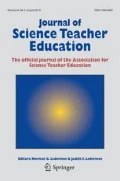Abstract
In this manuscript, we use a “learning to notice” framework to suggest that preservice elementary teachers bring a range of interpretations and responses to their students’ funds of knowledge and science teaching and learning. By examining data from three sections of an elementary methods course, we find that preservice teachers recognized students’ funds of knowledge, assigned value to them, and took account of these resources for science learning in their planning. While preservice teachers most often described funds of knowledge as a “hook” to gain and sustain students’ interest in the science classroom, they also interpreted and utilized funds of knowledge in other ways, including as substantive contributions to meaning making and positioning students as having expert knowledge.
Similar content being viewed by others
References
Bouillion, L. M., & Gomez, L. M. (2001). Connecting school and community with science learning: Real world problems and school-community partnerships as contextual scaffolds. Journal of Research in Science Teaching, 38(8), 878–898.
Buck, P., & Skilton-Sylvester, P. (2005). Preservice teachers enter urban communities: Coupling funds of knowledge research and critical pedagogy in teacher education. In N. González, L. C. Moll, & C. Amanti (Eds.), Funds of knowledge: Theorizing practices in households, communities and classrooms (pp. 213–232). Mahwah, NJ: Lawrence Erlbaum.
Clement, J. (1982). Students’ preconceptions in introductory mechanics. American Journal of Physics, Physics Education Supplement, 50, 291–299.
Cochran-Smith, M., & Zeichner, K. M. (Eds.). (2005). Teacher education: The report of the AERA panel on research and teacher education. Mahwah, NJ: Lawrence Erlbaum.
Daiute, C. (1993). Youth genres and literacy: Links between sociocultural and developmental theories. Language Arts, 70(5), 402–416.
Duschl, R. A., Schweingruber, H. A., & Shouse, A. W. (2007). Taking science to school: Learning and teaching science in grades K-8. Washington: National Research Council.
García, S. B., & Guerra, P. L. (2004). Deconstructing deficit thinking: Working with educators to create more equitable learning environments. Education and Urban Society, 36(2), 150–168.
Gee, J. P. (1999). An introduction to discourse analysis: Theory and method. London and New York: Routledge.
Glaser, B. G., & Strauss, A. L. (1967). The discovery of grounded theory: Strategies for qualitative research. Chicago, IL: Aldine.
González, N., Andrade, R., Civil, M., & Moll, L. C. (2001). Bridging funds of distributed knowledge: Creating zones of practices in mathematics. Journal of Education for Students Placed at Risk, 6, 115–132.
González, N., & Moll, L. C. (2002). Cruzando el puente: Building bridges to funds of knowledge. Educational Policy, 16(4), 623–641.
Gutierrez, K. D. (2002). Studying cultural practices in urban learning communities. Human Development, 45, 312–321.
Lave, J., & Wenger, E. (1991). Situated learning: Legitimate peripheral participation. Cambridge: Cambridge University Press.
Lee, O., & Fradd, S. H. (1998). Science for all, including students from non-English-language backgrounds. Educational Researcher, 27(4), 12–21.
Lee, O., & Luykx, A. (2007). Science education and student diversity: Race/ethnicity, language, culture, and socioeconomic status. In S. K. Abell & N. G. Lederman (Eds.), Handbook of research in science education. Mahwah, NJ: Lawrence Erlbaum Associates.
Lee, C. D., & Majors, Y. J. (2003). ‘Heading up the street:’ Localised opportunities for shared constructions of knowledge. Pedagogy, Culture and Society, 11(1), 49–68.
Moje, E., Collazo, T., Carillo, R., & Marx, R. W. (2001). “Maestro, what is ‘quality?’”: Language, literacy, and discourse in project-based science. Journal of Research in Science Teaching, 38(4), 469–498.
Moje, E., McIntosh Ciechanowski, K., Kramer, K., Ellis, L., Carrillo, R., & Collazo, T. (2004). Working toward third space in content area literacy: An examination of everyday funds of knowledge and discourse. Reading Research Quarterly, 39(1), 38–70.
Moll, L. C., Amanti, C., Neff, D., & González, N. (1992). Funds of knowledge for teaching: Using a qualitative approach to connect homes and classrooms. Theory into Practice, 31(2), 132–141.
Nicoll, G. (2001). A report of undergraduates’ bonding misconceptions. International Journal of Science Education, 23, 707–730.
Patton, M. O. (1990). Qualitative evaluation and research methods (2nd ed.). Newbury Park, CA: Sage.
Rosebery, A., & Hardicourt-Barnes, J. (2006). Using diversity as a science strength in the classroom: The benefits of science talks. In K. Worth, M. Klentschy, & R. Douglas (Eds.), Linking science and literacy in the K-8 classroom. Arlington, VA: NSTA Press.
Rosebery, A. S., & Warren, B. (Eds.). (2008). Teaching science to English language learners. Arlington: NSTA Press.
Schultz, K., Jones-Walker, C. E., & Chikkatur, A. P. (2008). Listening to students, negotiating beliefs: Preparing teachers for urban classrooms. Curriculum Inquiry, 38(2), 155–187.
Upadhyay, B. R. (2006). Using students’ lived experiences in an urban science classroom: An elementary school teacher’s thinking. Science Education, 90, 94–110.
van Es, E. A., & Sherin, M. G. (2008). Mathematics teachers’ “learning to notice” in the context of a video club. Teaching and Teacher Education, 24(2), 244–276.
Warren, B., & Ogonowski, M. (2005). “Everyday” and “scientific”: Rethinking dichotomies in modes of thinking and science learning. In R. Nemirovsky, A. S. Rosebery, J. Solomon, & B. Warren (Eds.), Everyday matters in science and mathematics (pp. 119–148). Mahwah, NJ: Lawrence Erlbaum Associates.
Wells, G., & Claxton, G. (Eds.). (2002). Learning for life in the 21st Century: Sociocultural perspectives on the future of education. Malden, MA: Blackwell.
Author information
Authors and Affiliations
Corresponding author
About this article
Cite this article
McLaughlin, D.S., Calabrese Barton, A. Preservice Teachers’ Uptake and Understanding of Funds of Knowledge in Elementary Science. J Sci Teacher Educ 24, 13–36 (2013). https://doi.org/10.1007/s10972-012-9284-1
Published:
Issue Date:
DOI: https://doi.org/10.1007/s10972-012-9284-1



